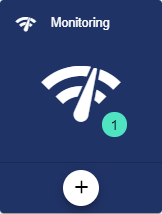Monitoring
Monitoring checks whether measured values fall below a specific minimum or exceed a specific maximum. Monitoring therefore includes measured values such as fill level or flow rate. Monitored objects can be used to trigger Events.
The configuration unit can only be used if the SCADA-Lizenz comprises the module "Extended events".
By selecting the "Monitoring" button, you can edit a monitoring operation that was created earlier. A new monitoring operation is created via the Plus button.

Assign the name of the monitoring operation in the Basic configuration. The Description field is optional. The "Group" field shows the Client in which the monitoring operation was created. The path is generated automatically by the system.

In the Settings field, select the Monitoring type.

Minimum monitoring: To trigger a message for the alarm, the data from the selected database must have fallen below the set minimum at least once.
The alarm can be triggered at any later time. (e.g. 8:00 a.m.)Maximum monitoring: To trigger a message for the alarm, the data from the selected database must have exceeded the set maximum at least once.
The alarm can be triggered at any later time. (e.g. 8:00 a.m.)Periodic maximum monitoring: To trigger a message for the alarm in the designated time interval, the data from the selected database must reach one of the set values.
Plausibility monitoring: The data from the selected database must be within the set range. This ensures the functionality of the counters. This means that counter failures can be noticed more quickly.
Position monitoring: If the unit is outside the specified coordinates, a message is triggered for the alarm.
The alarm schedule is activated or deactivated via the "Activated" checkbox.
Advanced Settings

Select type
Signal: Select a signal that was created for your system, whose value or coordinates are to be monitored.
Formula: Select a formula that was created for your system, which is to be executed.
Select the object in the system that is to be monitored.
Select the value interval type (see table "Possible interval types")
Specify the minimum value, the range of the value and the minimum result.
Possible interval types:
Interval Type | Description |
|---|---|
Process interval | The process interval corresponds to the interval set in the signal. |
Minor interval | Equivalent to 15 minutes and is therefore the smallest interval. |
Hourly interval | Equivalent to one hour and thus 4 times the minor interval. |
Two-hourly interval | Equivalent to two hours and thus twice the hourly interval. |
Daily interval | Equivalent to 24 hours and thus 12 times the two-hourly interval. |
Weekly interval | Equivalent to 7 days (168 hours) and thus 7 times the daily interval. |
References
All references to this monitoring operation are displayed in the References.
